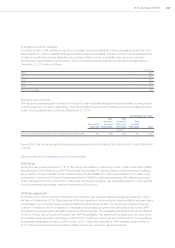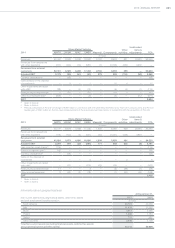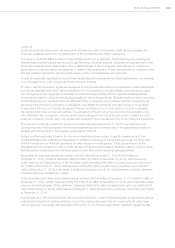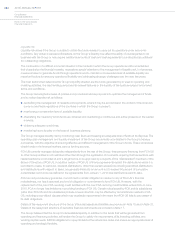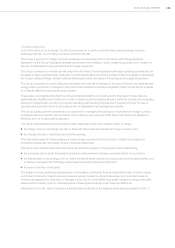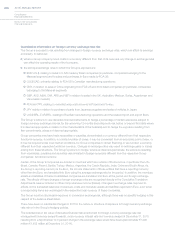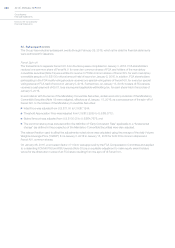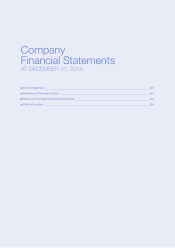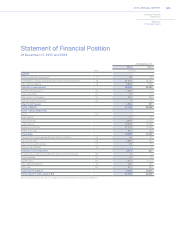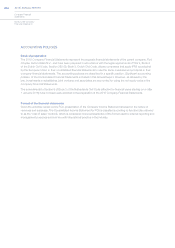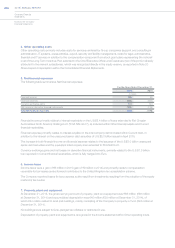Chrysler 2015 Annual Report Download - page 237
Download and view the complete annual report
Please find page 237 of the 2015 Chrysler annual report below. You can navigate through the pages in the report by either clicking on the pages listed below, or by using the keyword search tool below to find specific information within the annual report.
2015 | ANNUAL REPORT 237
Receivables, payables and future trade flows whose hedging transactions have been analyzed were not considered in
this analysis. It is reasonable to assume that changes in exchange rates will produce the opposite effect, of an equal or
greater amount, on the underlying transactions that have been hedged.
Quantitative information on interest rate risk
The manufacturing companies and treasuries of the Group make use of external borrowings and invest in monetary
and financial market instruments. In addition, Group companies sell receivables resulting from their trading activities
on a continuing basis. Changes in market interest rates can affect the cost of the various forms of financing, including
the sale of receivables, or the return on investments, and the employment of funds, thus negatively impacting the net
financial expenses incurred by the Group.
In addition, the financial services companies provide loans (mainly to customers and dealers), financing themselves using
various forms of direct debt or asset-backed financing (e.g. factoring of receivables). Where the characteristics of the
variability of the interest rate applied to loans granted differ from those of the variability of the cost of the financing obtained,
changes in the current level of interest rates can affect the operating result of those companies and the Group as a whole.
In order to manage these risks, the Group uses interest rate derivative financial instruments, mainly interest rate
swaps and forward rate agreements, when available in the market, with the object of mitigating, under economically
acceptable conditions, the potential variability of interest rates on Net profit/(loss).
In assessing the potential impact of changes in interest rates, the Group segregates fixed rate financial instruments
(for which the impact is assessed in terms of fair value) from floating rate financial instruments (for which the impact is
assessed in terms of cash flows).
The fixed rate financial instruments used by the Group consist principally of part of the portfolio of the financial services
companies (basically customer financing and financial leases) and part of debt (including subsidized loans and notes).
The potential loss in fair value of fixed rate financial instruments (including the effect of interest rate derivative financial
instruments) held at December31, 2015, resulting from a hypothetical 10 percent change in market interest rates,
would have been approximately €85 million (approximately €100 million at December31, 2014).
Floating rate financial instruments consist principally of cash and cash equivalents, loans provided by the financial
services companies to the sales network and part of debt. The effect of the sale of receivables is also considered in
the sensitivity analysis as well as the effect of hedging derivative instruments.
A hypothetical 10 percent change in short-term interest rates at December31, 2015, applied to floating rate financial assets
and liabilities, operations for the sale of receivables and derivative financial instruments, would have resulted in increased net
financial expenses before taxes, on an annual basis, of approximately €7 million (€12 million at December31, 2014).
This analysis is based on the assumption that there is a general change of 10.0 percent proportionate to interest rate
levels across homogeneous categories. A homogeneous category is defined on the basis of the currency in which
the financial assets and liabilities are denominated. In addition, the sensitivity analysis applied to floating rate financial
instruments assumes that cash and cash equivalents and other short-term financial assets and liabilities which expire
during the projected 12 month period will be renewed or reinvested in similar instruments, bearing the hypothetical
short-term interest rates.
Quantitative information on commodity price risk
The Group has entered into derivative contracts for certain commodities to hedge its exposure to commodity price risk
associated with buying raw materials and energy used in its normal operations.
In connection with the commodity price derivative contracts outstanding at December31, 2015, a hypothetical
10.0 percent change in the price of the commodities at that date would have caused a fair value loss of €40 million
(€50 million at December31, 2014). Future trade flows whose hedging transactions have been analyzed were not
considered in this analysis. It is reasonable to assume that changes in commodity prices will produce the opposite
effect, of an equal or greater amount, on the underlying transactions that have been hedged.


